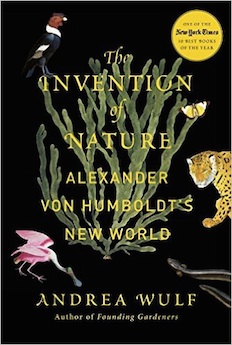By Lewis Fried
The name “Humboldt” is as ubiquitous as the achievements of its most known bearer. Alexander Von Humboldt, a child of Prussia’s nobility, had literally and metaphorically wandered far from the privileges of his home, class, and social expectations. By the time of his death in 1859, he had impressed his name upon natural sciences, geographic exploration, politics, and travel writing. Those he influenced and corresponded with, and the numerous, influential concepts he developed are inseparable from the culture and civilization of that time as well as ours. Goethe, Schiller, Haeckel, Jefferson, Emerson, Thoreau, Whitman and Bolivar fell within Humboldt’s enlarging sphere of influence. Those who followed in Humboldt’s footsteps—biologists, naturalists, cosmologists, social thinkers, writers, and explorers—enhanced his legacy, making it part of an intellectual heritage. Why, then, is Humboldt’s work so dim in our day? And how to assess and sum it up?
The Invention of Nature addresses these questions, but it also does more. Who Humboldt was is counterpointed by the opportunities he seized; the notions of nature and culture he inherited; and his re-presentations of such, transforming how environment and society could be and are understood. The book begins with an account of Humboldt’s harrowing 1802 climb of Chimborazo, an inactive volcano some 100 miles south of Quito; details his life within the history, politics, and science of his time; and ends with thematic sections discussing the impact of his ideas on several individuals, entitled, for example, as “Man and Nature: George Perkins Marsh and Humboldt.”
Wulf unfolds Humboldt’s life and accomplishments within the conceptual framework he developed. Although Humboldt was an avid specimen collector, his major concept can be traced to his climbing Chimborazo, a trek taking him approximately 19,413 feet up this snow-capped mountain. Measuring temperature, air pressure, the boiling point of water, and collecting air samples as he went, he synthesized the data, and compared and connected the vegetation and animal life that he had seen both there and on his travels. Presciently, he concluded that nature was a “web of life.” Its aspects were not autonomous presences but inextricably parts of a whole—a entirety that was dynamic.
He sketched his pioneering Naturgemalde. Wulf explains that this name is untranslatable; it can refer to a “painting of nature” implying “a sense of unity or wholeness.” His first presentation of this, a cross-section of the mountain, correlated plants and animals with zones. Connections were made across the map, so that looking at the illustration, one finds different “levels of plants, along with details of how they were linked” to their place on the mountain, as well as to “temperature and so on.” Moreover, these specifics were then set in the context of yet other places. By doing so, Humboldt challenged conventional taxonomy. Plants could now be understood in the light of geography and climate. The implications of this remain far-reaching, both theoretically and practically. There are no autonomous facts, or independent organisms whose lives might adequately be abstracted, and viewed as self-contained. Nature is a “web of life,” and to make sense of this, no one specialty suffices.
If plants and animals could be seen in this light, so, too, society. For example, his militant condemnation of slavery, found for instance in his Political Essay on the Island of Cuba demonstrated that “climate, soils and agriculture with slavery, demographics and economics” were intertwined.
His widening grasp of nature and culture led to his sweeping Cosmos. At 65, and with helpers, he wrote about his grand ambition: “The mad frenzy has seized me of representing in a single work the whole material world.” Cosmos, almost inexhaustibly, took the reader “from outer space to earth,” as Wulf puts it. Its introduction, Wulf writes, “spelled out his vision—of a world that pulsated with life.” Nature was a “living whole.“ The second volume, ranging from “ancient civilizations” to the then-modern age, assessed historical figures as well as cultural development. The work fascinated the public. By 1849, Wulf tells us, approximately 40,000 English copies of Cosmos were sold, excluding American runs of the book.
How can we not ask, as Wulf does, why Humboldt is not now a vibrant presence? In a short epilogue, answers are given. Humboldt’s encompassing vision had become déclassé, pushed into disfavor by the rise of narrow specialization. Moreover, anti-German opinion, given World War I, and II, saw little value in celebrating German achievements. Now, with trepidation, we are watching the collapse of ecosystems small and large; we read daily about assessments of natural and social devastation. We understand—at least most of us agree—that “economic forces and climate change” cannot be separated.
Wulf’s narrative is spellbinding. Drawing on Humboldt’s correspondence, his journals, his books, and the views of him held by those who knew him, she well presents his sensibilities and his ceaseless ambitions. An illuminating writer, Wulf offers us a spacious reading of Humboldt and his epoch, mapping many of the prospects we have in front of us.
Lewis Fried (ΦBK, Queen’s College, CUNY, 1964) is Professor of English Emeritus at Kent State University and a resident member of the Nu of Ohio chapter of Phi Beta Kappa.




